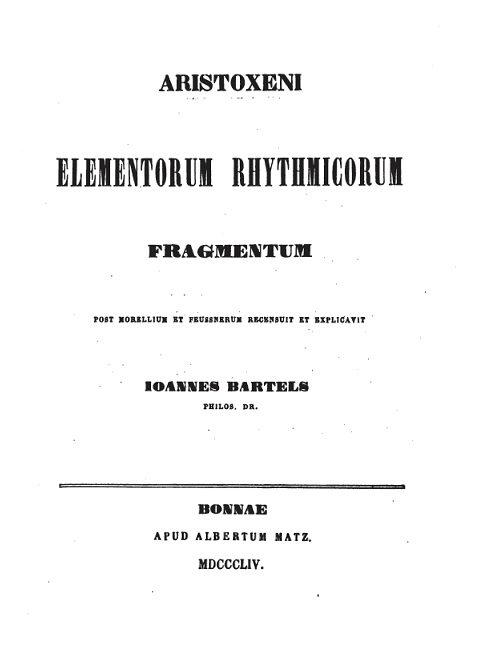Aristoxenus of Tarentum, Elements of Rhythm : Text, Translation, and Commentary with a Translation and Commentary on POxy 2687, by Christopher C. Marchetti – A Dissertation submitted to the Graduate School-New Brunswick Rutgers, The State University of New Jersey, 2009, 320 p.
Abstract : Aristoxenus of Tarentum makes productive use of Aristotelian concepts and methods in developing his theory of musical rhythm in his treatise Elements of Rhythm. He applies the Aristotelian distinction between form and material and the concept of hypothetical necessity to provide an explanation for why musical rhythm is manifested in the syllables of song, the notes of melody, and the steps of dance. He applies the method of formulating differentiae, as described in Aristotle’s Parts of Animals, to codify the formal properties of rhythm.
Aristoxenus’ description of the rhythmic foot presents several interpretive challenges. Our text is fragmentary, and we lack Aristoxenus’ definitions of several key terms. This study seeks to establish the meanings of these terms on the basis of a close examination of the structure of Aristoxenus’ argument. Parallel passages in Aristides Quintilianus’ On Music are considered in detail for their consistency or lack thereof with Aristoxenian usage. Parallel passages in POxy 2687 are cited as illustrations for several rhythmic constructions and principles Aristoxenus mentions ; because these involve original interpretations of some points in POxy 2687, they are supported by a thorough presentation of POxy 2687 in a separate chapter.
One central conclusion of this study is that Aristoxenus viewed rhythmic feet as musical functions, analogous to the theory of melodic functions he had presented in his Elements of Harmony. Only limited conclusions about the applicability of Aristoxenus’ theory to the history of ancient Greek music can be justified. While some of the extant remains of Greek music are in accord with Aristoxenian theory, others contradict it. Much of ancient poetry is more rhythmically complex than what is presented in our text of E.R., but regular poetic forms such as the anapestic dimeter and the stately rhythms of religious hymns may have provided the original starting points for subsequent rhythmic developments Aristoxenus seeks to explain.

